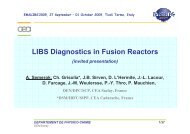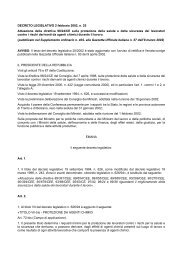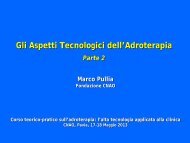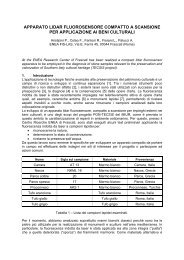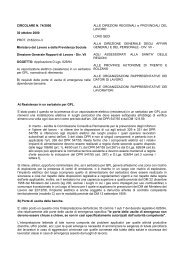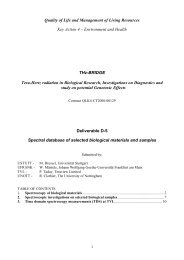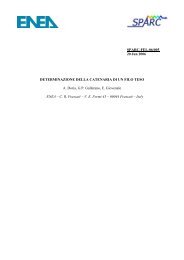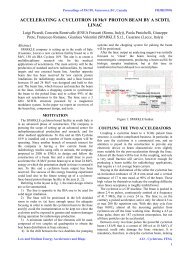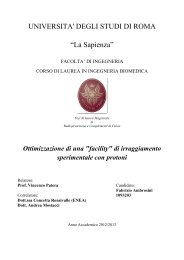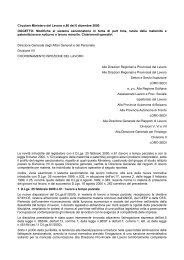Theory, Design and Tests on a Prototype Module of a Compact ...
Theory, Design and Tests on a Prototype Module of a Compact ...
Theory, Design and Tests on a Prototype Module of a Compact ...
Create successful ePaper yourself
Turn your PDF publications into a flip-book with our unique Google optimized e-Paper software.
12 2. LINAC AND SCL ACCELERATORS<br />
at a differentiati<strong>on</strong> <strong>of</strong> the structure with respect to the type <str<strong>on</strong>g>and</str<strong>on</strong>g> the<br />
velocity <strong>of</strong> the particles.<br />
Figure 2.4. Schematic view <strong>of</strong> the Wideröe drift-tube<br />
linac. D are drift tubes, V is an alternating voltage<br />
source, G are the gaps between the drift tubes <str<strong>on</strong>g>and</str<strong>on</strong>g> S<br />
is the source <strong>of</strong> a c<strong>on</strong>tinuos beam. B are used to group<br />
the particles in bunches.<br />
The Wideröe linac c<strong>on</strong>cepts was to apply a time-alternating voltage<br />
to a sequence <strong>of</strong> drift tubes whose lengths increased with the particles<br />
velocity, so the particles always arrive synchr<strong>on</strong>ously at each gap between<br />
tubes. In figure 2.4 a schematic view is presented, D are drift<br />
tubes c<strong>on</strong>nected to an alternating voltage source V that applies equal<br />
<str<strong>on</strong>g>and</str<strong>on</strong>g> opposite voltages to sequential drift tubes, G are the gaps between<br />
the drift tubes in which the electric force acts to accelerate the<br />
particles, <str<strong>on</strong>g>and</str<strong>on</strong>g> S is the source <strong>of</strong> a c<strong>on</strong>tinuous i<strong>on</strong> beam. For efficient<br />
accelerati<strong>on</strong> the particles must be grouped into bunches, shown by the<br />
black dots, which are injected into the linac at the time when the polarity<br />
<strong>of</strong> the drift tubes is correct for accelerati<strong>on</strong>. The bunching can<br />
be accomplished by using an RF gap B between the DC source <str<strong>on</strong>g>and</str<strong>on</strong>g><br />
the linac. The original Wideröe linac c<strong>on</strong>cept was applicable to heavy<br />
i<strong>on</strong>s <str<strong>on</strong>g>and</str<strong>on</strong>g> not suitable for accelerati<strong>on</strong> to high energy <strong>of</strong> lighter prot<strong>on</strong>s<br />
<str<strong>on</strong>g>and</str<strong>on</strong>g> electr<strong>on</strong>s where the drift-tube lengths <str<strong>on</strong>g>and</str<strong>on</strong>g> the distances between<br />
accelerating gaps would be too large, resulting in a small accelerating<br />
rates, unless the frequency <strong>of</strong> accelerating field could be increased up<br />
to 1 GHz. But in this range <strong>of</strong> frequencies the wavelengths are comparable<br />
with the sizes <strong>of</strong> the drift tubes <str<strong>on</strong>g>and</str<strong>on</strong>g> propagati<strong>on</strong> <str<strong>on</strong>g>and</str<strong>on</strong>g> radiati<strong>on</strong><br />
effects should be included in the design.<br />
Linear accelerators are quasi-periodic 4 structures where the single<br />
elements, which could be res<strong>on</strong>ant cavities, are coupled together either<br />
electrically or magnetically.<br />
2.1. Disc-loaded structure. It is <strong>of</strong>ten used for electr<strong>on</strong>s. Starting<br />
from the idea that the electric field in a uniform circular waveguide<br />
cannot provide c<strong>on</strong>tinuous accelerati<strong>on</strong> <strong>of</strong> electr<strong>on</strong>s, since the phase velocity<br />
always exceed the velocity <strong>of</strong> light, <strong>on</strong>e can think to lower the<br />
4 The structure is quasi-periodic, since the l<strong>on</strong>gitudinal dimensi<strong>on</strong> <strong>of</strong> the single<br />
element has to be adequate to the increased particle velocity during the travel.





